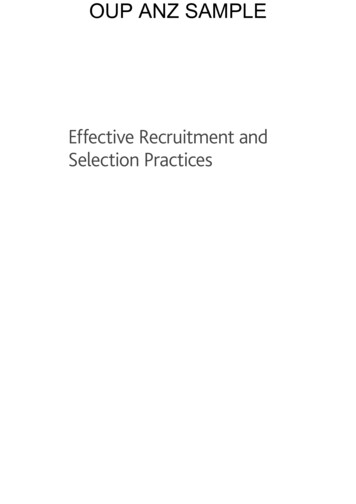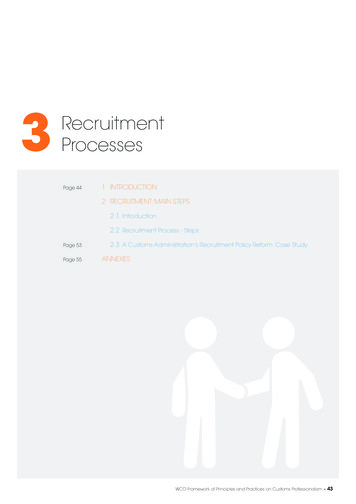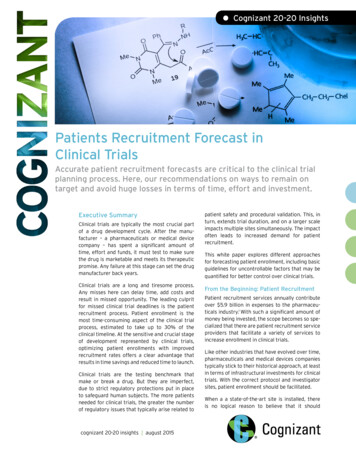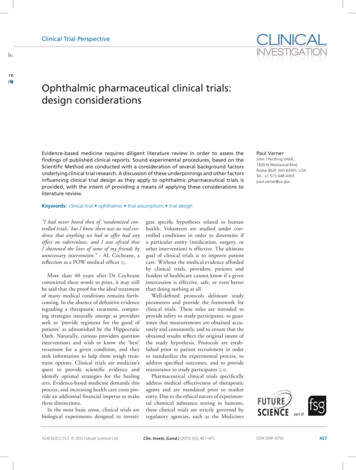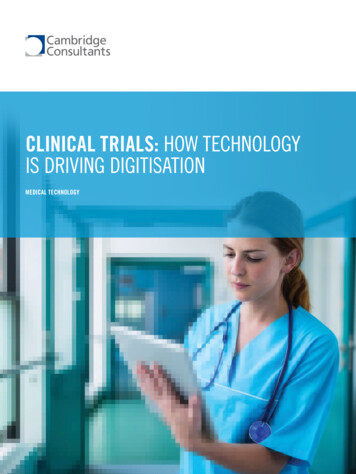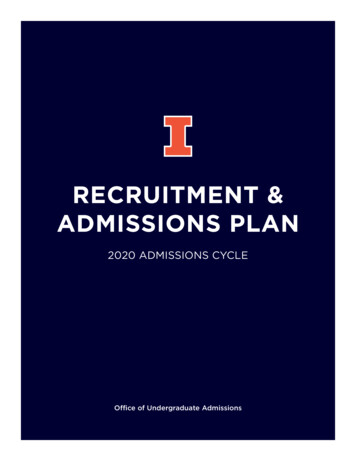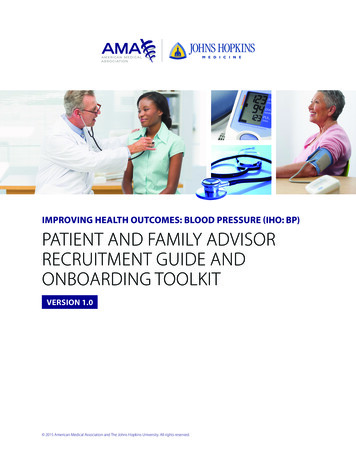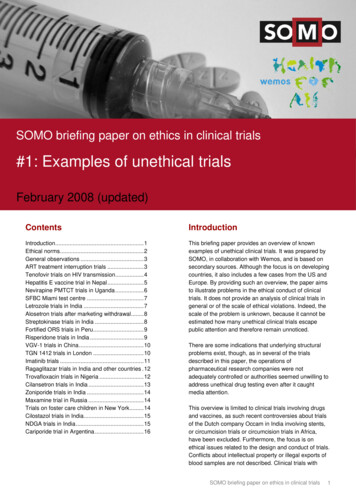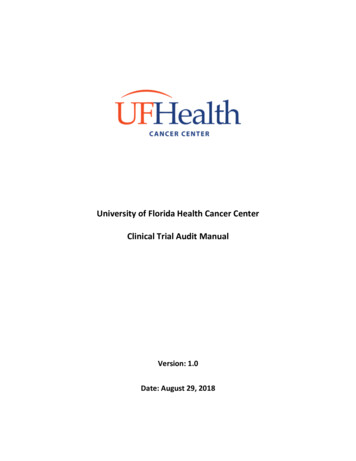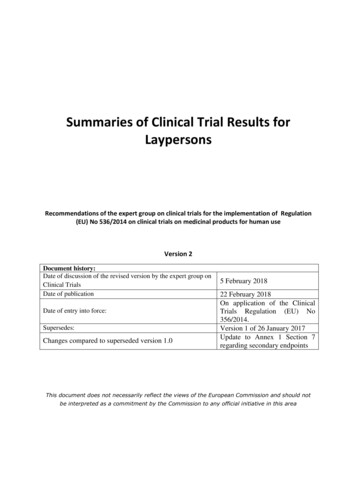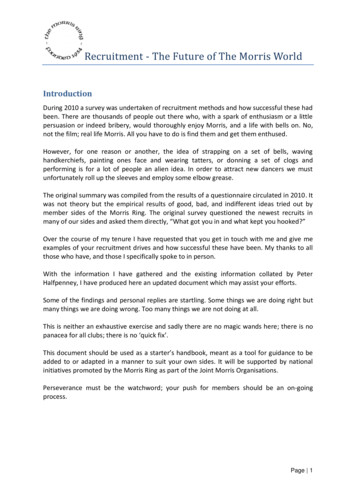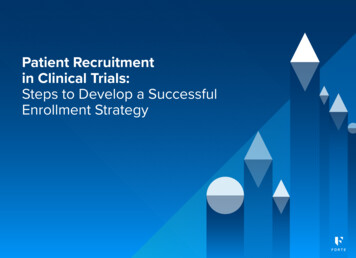
Transcription
Patient Recruitmentin Clinical Trials:Steps to Develop a SuccessfulEnrollment Strategy
PATIENT RECRUITMENT IN CLINICAL TRIALSTableofContentsIntroduction3Chapter 1: Determining feasibility4Chapter 2: Building an advertising strategy11Chapter 3: Launching your recruitment campaign19Chapter 4: Tracking your progress26Conclusion33Additional resources34
PATIENT RECRUITMENT IN CLINICAL TRIALSIntroductionRecruiting study participants is arguably the most critical part of the clinical trial process; but it’s also one of themost challenging. During Forte’s 2017 national survey of over 900 clinical research professionals, recruitingenough participants to trial was identified as one of the top three pain points in clinical trial conduct.So, why is it that such an important element of clinical research is also one of the most difficult to execute?Strategic preparation is critical to successfully recruiting and enrolling qualified participants to a clinical trial.All too often research institutions take on a study without dedicating the necessary resources (time, effort andmoney) to develop an effective recruitment strategy, relying on their industry sponsor to already have a planin place, or believing institutional name recognition will bring potential participants knocking. This approach topatient recruitment can result in low and slow patient accrual that negatively influences the clinical trial.Under-enrolling studies come with a number of consequences that affect all stakeholders—sites, sponsors,patients and the general public. Not only can keeping low accruing trials open waste time and money, butit also diminishes the scientific validity of the study and raises ethical concerns for participants alreadyenrolled.To proactively prevent low accrual, it’s imperative for research institutions to build patient-recruitmentstrategies that are well-planned and fit within protocol budgets and timelines. This eBook outlines bestpractices to help your organization develop and implement successful pre-recruitment practices, build andlaunch strategic advertising campaigns and use metrics to identify and prevent under-enrollment.3
PATIENT RECRUITMENT IN CLINICAL TRIALSChapter 1Determining feasibilityPatient recruitment is a significant consideration when determining whether ornot your team can agree to take on a study. The type of study, the number ofparticipants required for a particular protocol, the available number of patients torecruit from and your ability to screen those patients are only a few of the factorsto take into account during the feasibility assessment.
PATIENT RECRUITMENT IN CLINICAL TRIALSExplore your database ofpotential participantsThe highest-quality and least-expensive participantsto enroll are the ones that come from yourinstitution’s own database. Individuals in yourdatabase already have a relationship with yourorganization, they’re familiar with your institution’sresearch and are likely interested in participatingin research. For these reasons, any recruitmentstrategy you deploy should begin with an internalfocus.Search your EMRConduct an analysis of your electronic medicalrecords (EMR), with IRB approval as needed, to seehow many participants are already coming in withthe desired qualifications: Do you have an adequate population to accrue therequired number of participants? Are you reasonably able to reach these potentialparticipants?5 Is the population adequately representative for theprotocol?It’s also important to determine if and/or how manyprotocols with similar criteria are already open atthe institution. Competing studies can complicateyour recruitment efforts by limiting your eligibleparticipant population.Engage area physiciansAssess which physician networks and hospitalswould be willing to help you recruit through referrals. Do these organizations have sizable populations ofpotentially qualified patients? What is your plan to encourage referrals?Physician referrals are invaluable to patientrecruitment efforts, as they are one of the mostefficient means of finding and enrolling qualifiedpatients. However, some physicians may beconcerned they will lose their primary care patientsif they refer them to a trial. Be sure you have a planin place to work with physicians and effectivelycommunicate your efforts and intentions.
PATIENT RECRUITMENT IN CLINICAL TRIALS6Assess past enrollmentperformanceData is incredibly valuable to completing an accurate feasibilityassessment. If you’ve conducted similar studies in the past, lookat how well you accrued patients to those trials. This assessmentcould include studies you’ve conducted with the same sponsoror sponsor type, same trial phase and/or the same condition.Understanding your past performance will help you determine amore accurate and feasible enrollment estimate and will allow youto adequately manage finances and staff resources if you take onthe study.Understanding the right metrics to use to predict enrollmentbegins by knowing the questions you’re trying to answer. Whenassessing the enrollment of past studies, a few common questionsinclude: How many total participants did we accrue to this trial? Did this trial meet target enrollment? What did our accrual timeline look like? Were there any delays caused by low or slow accrual? How many screen failures did we see for this study? What recruitment campaigns were utilized in the study?
PATIENT RECRUITMENT IN CLINICAL TRIALS7While the path to uncovering the most effectivePercent target enrollment metmetrics to measure your operational performanceUse this metric to see if and how much of therequires significant consideration, here are a fewenrollment goal was achieved for past studies.common metrics that can be useful when assessingIf this percentage is low, it doesn’t bode well forpast performance to determine feasibility:future studies with similar criteria.Number of participants enrolledMetrics are a powerful tool to help you makeThis metric tells you how many total participantseducated decisions about study opportunities. Takeyou accrued to a trial (consented and eligible).past performance into consideration before youYou’re likely to accrue a similar number of peopleagree to a study so you (and the sponsor) can befor similar studies, particularly those in the sameconfident you’re capable of achieving the requiredtherapeutic area.enrollment numbers.Open to enrollment to first participant inFind out how long it took to enroll your firstTip: Provide an honest enrollmentparticipant to trial. If it took a significant amount ofestimate to your sponsor up front.time to accrue one person, it could indicate that aGiving your sponsor numbers thatdifferent recruitment method is needed or that thisare unfeasible for your populationis a difficult study type to accrue to. Use this metricas a starting point for additional investigation intopast problem areas.could set your site up for failurebefore you even activate the study.Learn more ways to gain actionable insights for more accurate enrollment estimates. Explore Forte Insights.
PATIENT RECRUITMENT IN CLINICAL TRIALSAsk your sponsor feasibilityquestionsIf the clinical trial is sponsor-funded, there are anumber of questions that are necessary for you toask to gain a better understanding of what will berequired of your site. Here are a few that are mostsignificant for enrollment planning: When did you open the trial to accrual? How many sites are currently accruing8 Will we need to develop our own internal tools inaddition to, or as a replacement, to yours to get thepopulation we need?The number of sites currently accruing patients canbe particularly significant when assessing enrollmentfeasibility. If there are multiple sites actively enrollingparticipants to the same study, and you’re the sixthor seventh site opened in your area, it’s possible thepool of participants could already be depleted.participants? How many sites within XX miles are accruing tothis study? How many participants have been accruedalready?Tip: Go onto ClinicalTrials.gov Will you give us a ready-made recruitment plan?and see which institutions are If yes, have materials for this plan already beenopen to enrollment for this studyIRB-approved? How successful has the recruitment campaignbeen? What is the recruitment budget?in your area.
PATIENT RECRUITMENT IN CLINICAL TRIALS9Conduct a SWOT analysisAs a research team, analyze the strengths, weaknesses,opportunities and threats (SWOT) of a protocol, both specifically forenrollment as well as the many additional aspects of a trial, to helpyour site identify potential issues and drawbacks before you agreeto take on the study. The SWOT analysis is a common tool used inmany industries to help individuals and organizations consider allof the potential impacts of a decision before it is made. With thehelp of your research team, determine 3-4 points that fit into eachof these categories: Strengths Weaknesses Opportunities Threats
TITLE GOES HERE TITLE GOES HERE10StrengthsOpportunitiesIn this section, consider what appeals to you aboutIn this section, determine external opportunities thatthe protocol and how it emphasizes your internalexist for your organization as well as any other peersite strengths. For example, discuss:institution. For example, consider: What about this protocol do you think will work Could this protocol advance treatment optionswell at your site?and/or prevention for the studied condition? Does your site specialize in this therapeutic area? Will taking on this study bring your institution Does the public recognize your organization for itssubstantial return on investment (i.e., recognition,expertise in this area of research?capital, experience, etc.)? Have you previously accrued an adequate number Would taking on this study increase your databaseof participants for similar studies?of people potentially eligible for additional trials? Do the eligibility requirements align accurately witha significant portion of your participant population?ThreatsLike opportunities, this section should focus on theWeaknessesexternal threats for your institution as well as yourLike the strengths, this section should focus on howpeer institutions.the protocol relates to the internal weaknesses of Would this study be competing with other openyour site. For example, discuss questions like:trials in your geographic area? Does your site have the resources to accrue an Is the protocol exploring a common condition thatadequate number of participants?is widely researched? Are there trials open to enrollment that could Are other institutions more known for research incompete with this study?this therapeutic area? Have you previously seen low enrollment for thistype of disease?
PATIENT RECRUITMENT IN CLINICAL TRIALSChapter 2Building an advertising strategyMarketing and advertising have become more sophisticated in past years, andyou’re now able to spend advertising dollars more intelligently. Whereas withtraditional marketing you would blast a single product and message to the masses,you now can deliver specific and targeted messages that resonate with a specificgroup of people. Personalized messages drive people to take action much fasterthan a message for the masses.So, who is that specific audience? The keys to marketing aren’t your logo or thecolors you use–it’s knowing your audience inside and out. Once you know youraudience, you can begin to craft the right strategy and message to reach that theright participants.
PATIENT RECRUITMENT IN CLINICAL TRIALSDefine your targetaudienceBefore you start reaching out to potentialparticipants, take the time to research andunderstand who it is you’re trying to reach with yourrecruitment efforts—what is your target participantpopulation?Answer these questions to maximize theeffectiveness of your recruitment plan:Who is your ideal participant?The inclusion/exclusion criteria associated with theprotocol is a good place to start when answeringthis question. Identify the target demographicsof your ideal participant, including factors suchas gender, age, location as well as specificprotocol requirements. Determine where thepeak prevalence/incidence rates are, and let thatinformation guide your recruitment strategy.12However, be careful not to limit your reach too much.If your specifications become too narrow, it may betough to market to that group; keep your definedpopulation as high-level as possible.Where does your ideal participant go forinformation?To know where to publish ads to promote a trial, youneed to know where your audience will see them.What channels do they visit?Demographics often play a key role in where apatient is most likely to search for information.For example, a 19-year-old patient is probablymore likely to search social media sites, whereasa 70-year-old patient may find information in anewspaper. Choose the information outlets youknow your audience will be using, eliminating theneed to advertise in places that will provide little tono results.
PATIENT RECRUITMENT IN CLINICAL TRIALS13How does your ideal participant engage with advertisements/content?To increase the likelihood that your ideal participant will payattention to your study ads, you need to know what types ofcontent they are most likely to engage with. Is your audiencemore likely to download something? Or would they rather hold apamphlet in their hand? Do they prefer to read a blog post? Or arethey more likely to watch a video ad?Think about how your target audience would engage with thecontent you are looking to provide. Multiple internal and externalfactors can affect the type of content a patient is most drawn to,including literacy, attention span and available time. Adaptingstudy ads into the easiest and most enjoyable format for your idealparticipant will likely provide better results.
PATIENT RECRUITMENT IN CLINICAL TRIALSDevelop messagingthat resonates with youraudienceAgain, delivering a message that resonates beginswith knowing your audience. Look back at yourtarget participant population and determine whatmight motivate them to participate in your clinical14Take your identified motivators and try to find themost meaningful message for that population.Determine what message will drive your idealparticipants to find out more about your trial. Allthe while, remember that your messaging must beIRB-approved and void of any potentially coercivecontent.trial. Are they seeking new treatment? Will they benefit from the medical exams that willbe provided free-of-cost throughout the study? Is lack of health insurance inhibiting their treatmentoptions?Also consider whether or not your target populationis motivated by altruistic reasons. Is it motivating for people to know they’recontributing to the research community? Do they know someone affected by the studydisease?Tip: Don’t be afraid to explore theemotional side of advertising toprovide relevant and resonatingmessages for your population.
PATIENT RECRUITMENT IN CLINICAL TRIALS15Establish your online advertisingdatabaseAs you’re engaging with potential participants it’s important toTip: It’s good practice to be upfront with your participants whenit comes to email advertising byletting them know what they cancollect their email addresses. This allows you to follow up withthem to provide additional information and content that could leadthem to take action and agree to participate in your trial. Even ifthe participant isn’t interested in the study you’re promoting now,they might be interested in a future study you conduct.expect from you. This helps buildHowever, it’s important to note that you need to gain antrust with those in your databaseindividual’s permission if you want to communicate with them viaand could influence their choiceto engage with your site in thefuture.email. The Federal Trade Commission (FTC) has very clear rulesabout email communication in the CAN-SPAM Act. Permissionis clear consent from the individual to receive marketingcommunication in the future. This can be accomplished by addinga checkbox to your email sign-up that clearly states an opt-into your email communication. For example: “I agree to receivee-mails from X company for information about future studies andorganization news.”
PATIENT RECRUITMENT IN CLINICAL TRIALS16Create compelling and valuablecontentInstead of pushing information on your population, deliver helpfuland valuable content that attracts the right participant. Think aboutTip: Participant quotes and socialproof are a great way towhat content is helpful for your population. What can you providepotential participants that they will be grateful for?encourage positive perception ofDelivering content that’s genuinely useful for your targetyour site. A common statistic sayspopulation builds trust with potential participants. Having already90% of people will believe socialproof from someone they don’teven know as opposed to anadvertiser.gained value from your content, they may be more likely to takeaction and learn more about your study. A blog can be a very easyway to create content on your website that continues to bringpeople back to your site and encourages engagement. Bloggingis also a great way to connect with your community in generaland share the purpose of why your organization conducts clinicalresearch.
PATIENT RECRUITMENT IN CLINICAL TRIALS17Know where to put youradvertising materialsTip: It’s also important to thinkoutside of the box when determining where to put your advertisingmaterials. While the essential 3 L’sand 3 P’s could get yourOnce you have your messaging and advertising materials,you need to know where to put them to connect with the rightpopulation.Consider tactics for building clinical trial awareness by developingan understanding of your target population and placing advertisingmaterials where they live, learn, labor and pay, pray, play. Thismessage in front of the rightframework was developed by Karen Brooks, PhD candidate atpeople, a different tactic may proveTrident University, and she calls it the 3 L’s and 3 P’s. Its principalmore engaging and encouragegreater action from your idealparticipants, such as mailing abrochure along with people’s waterbill to build far reaching awareness.is that exploring the everyday actions and priorities of your idealparticipant can help you think deeper about how and whereit’s best to reach them with your messaging. If you know youraudience well enough, you know where all of these places are.
PATIENT RECRUITMENT IN CLINICAL TRIALS18Deliver a clear call to actionA critical part of any advertising campaign is a clear call to action.Determine what you want people who see your advertising to doand make sure it’s very clear what their next step is.Tip: Your call to action should beobvious enough that if someoneskims your content, whether it’s ablog post or brochure, they knowwhat action they should take.Make it as easy as possible foryour ideal participants to take thenext step. Do you want them to call and sign up for more information aboutthe trial? Should they attend an info session you’re hosting? Would you like them to provide their email address?
PATIENT RECRUITMENT IN CLINICAL TRIALSChapter 3Launching your recruitmentcampaign
PATIENT RECRUITMENT IN CLINICAL TRIALS20Determine where to spend yourmoneyOne of the most important aspects of your recruitment campaignis your budget. When budgeting for recruitment advertising, youalways want to create context by defining your goal. Ask yourself,how important is this protocol to your site this year? What is thepotential return for your organization?Where to put your dollarsThere are many targeted marketing options today that allow youto be hyper-specific about the population you are targeting andeliminate wasted advertising. When building your budget, try to setaside funds for: Paid ads Social media Google ads Local TV Magazine and radio Print materials
PATIENT RECRUITMENT IN CLINICAL TRIALS21Google AdWords is another good place to put your dollars. Thistool allows businesses to purchase keywords or phrases thattrigger ads to appear on the search results page. When used well,it can be very successful for gaining awareness, as it allows you toTip: If applicable, contact yourinstitutional public relations teamor communications center. Talkwith them and see if they’re willing and able to partner with youto spread the word about yourclinical trial. It’s possible they’llhelp you advertise, or at the veryleast, give you best practices foryour campaign.be strategic with keywords unique to you.Saving costs with free resourcesThere are a lot of low to no cost advertising options out there thatcan help you get your message to the right individuals, including: Organic social media: Social media that you don’t put dollarsbehind SEO: Optimizing your web content to include specific phrasesand words you know people are searching for to increase yourchances of being indexed on the Google search platform Email campaigns: Once you have someone’s email, you cancontact them for free or low cost Word of mouth: Social proof is incredibly valuable, particularlywhen coming from someone the individual knows.
PATIENT RECRUITMENT IN CLINICAL TRIALSPrepare your advertisingmaterialsCreating your advertisements is a big step in gettingyour campaign up and running. Use the messagingyou developed in the previous steps to build wellcrafted advertising materials that appeal to yourtarget population.Develop the creative for your campaignYou know your target population, you have yourmessaging, now it’s time to put together creativeimagery that resonates with the right individuals.Free tools like Canva allow you to easily createcustom graphics for everything from social mediaposts to business cards to flyers.Remember to update your creative to meet therequirements of each separate channel. Forexample, the images on a brochure are going torequire different dimensions than a Facebookpost. However, while each channel may requiredifferent graphic elements, the look and feel of your22campaign should be consistent across all materials.Update your websiteIt’s likely many of the call-to-actions in your webcontent will be to visit your organization’s websitefor more information. Before you post youradvertisements anywhere, ensure your website hasthe necessary information prospective participantsneed to make the decision to participate. Includeinformation about your research site and the clinicaltrial as well as contact information for the right staffmembers. Make it as easy as possible for people totake next steps.Internally communicate the launchDon’t underestimate the importance ofcommunicating your advertising campaign internallyat your organization. Notifying your site staff, aswell as other institutional departments, that you’readvertising for a particular study can encouragesharing and word-of-mouth recommendations,dramatically increasing your advertising reach.
PATIENT RECRUITMENT IN CLINICAL TRIALS23Schedule Social Media posts and adsHave a schedule for when and what you will beIf you’ve decided your target population is likely toposting to each platform: Don’t be afraid to post aengage with ads on social media, it’s important tovariety of different versions of your ad on the sameconsider these tips to help build successful posts:platform throughout a designated time period. Thiscan help guarantee more people see your ad andMake sure your message is appropriate for theallow you to experiment to see which ads are moreidiosyncrasies of each platform: Not only doessuccessful.each platform have unique message requirements(Twitter limits the number of text characters to 140),Meet the image requirements for each differentbut your audience uses each platform for differentplatform: This will ensure your creative elementsreasons. Alter your message to align with the reasondisplay correctly and nothing is skewed orindividuals use each platform. For example, a postmisinterpreted.on Facebook may be more sociable and visual,whereas a post on LinkedIn may be more formal andThere are a lot of free tools you can use to getdiscussion-based.your social media ads out there, including theplatforms themselves. If your site has a companyBe familiar with each platform’s algorithm for postingpage on Facebook, LinkedIn and/or Twitter, you canon people’s timelines: For example, Twitter postseasily create and track the progress of your postcan be quickly buried in a matter of minutes, whileengagement as a page administrator. HootsuiteLinkedIn posts tend to resurface for weeks.is another free tool that allows you to scheduleposts for multiple platforms in a single location andprovides growth and engagement analytics.
PATIENT RECRUITMENT IN CLINICAL TRIALS24Gain regulatory approval forrecruitment materialsIt takes a lot of work to get everything you need to start yourrecruitment campaign on the right track. But, along withdeveloping a strategy to provide the most relevant advertising toyour target population, you also need to ensure compliance. It’sessential to make sure all of your recruitment efforts fall in line withyour IRB and other institutional policies.What to get approvedDo your advertising materials need IRB approval? The answer isvery likely, yes. As a general rule of thumb, any material that youwill be putting in front of a potential study participant needs tohave prior IRB approval.Doctor-to-doctor and researcher-to-doctor communicationlikely needs IRB approval, as well (check with the IRB of record).For example, if you were to send information about a protocol(inclusion/exclusion criteria, etc.) to physicians to encourageparticipant referrals.
PATIENT RECRUITMENT IN CLINICAL TRIALS25Best practices for gaining approvalWhen submitting your recruitment materials forapproval, it’s best practice to also submit the typeof media you’ll be using. Give the IRB a sense ofTip: Be “specifically vague” about wherethings will be located. Including specificnot only of the information you’re presenting towebsites, social media sites and physicalpotential participants, but also the context that it’s in.locations for approval means those areIf possible, include pictures, mock-ups and/or scriptsthe only IRB-approved locations for yourwhen appropriate.advertising materials.You’ll also need to submit a plan for how you’ll beusing the materials. Provide the who, what, when,where, why and how for everything you submit. Tellthe IRB:Certainly, tell your IRB necessary locationinformation, but don’t limit yourself bybeing unnecessarily specific in where the How the materials will be usedmaterials will be posted. For example, in- Who the intended audience isstead of saying you’re going to post an ad What you’ll be using to display themon “www.favoriterecruitmentsite.com” say When and where they will be usedyou’re going to post the ad on “recruit- Why you chose this mediumThis comprehensive information will give your IRBthe necessary context to help them approve yourcampaign.ment websites such mentwebsite.com, etc.”
PATIENTPATIENTRECRUITMENTRECRUITMENTIN CLINICALIN CLINICALTRIALSTRIALSChapterChapter4 4TrackingTrackingyouryourprogressprogress
PATIENT RECRUITMENT IN CLINICAL TRIALS27Know your conversion rateTracking the appropriate data is key to both ensuring youradvertising campaign is successful and preparing you for the nextphase of recruitment. Organizing the follow up of your recruitmentcampaign is critical to seeing return on your invested efforts; andknowing how many participants you should expect to accrue willhelp you estimate the amount of time and resources you shouldarrange for tasks such as screening and scheduling visits withparticipants.Understand what to expectTake a look at both your protocol feasibility assessment andyour advertising strategy to determine the goal, milestone andconversion rate for your recruitment advertising campaign. Goal: How many participants do I need to accrue to this trial inorder for it to be successful? Milestone: How many people do I need to view my advertisingmaterials in order to reach my goal? Conversion rate: The percentage of individuals that view youradvertising materials and ultimately qualify and agree to participatein your study.
PATIENT RECRUITMENT IN CLINICAL TRIALS28Finding your conversion rateDetermining the conversion rate for your recruitment campaigncan help you establish the amount and scope of your advertising,and inform your strategy for distribution and channel. It can alsogive you a better understanding of the amount of resources youcan expect to dedicate to follow-up tasks. The more you track andmeasure your conversion rates, the better prepared you’ll be forthe individuals that respond to your recruitment campaign.The best way to get an accurate estimate of your conversionrate is to look back at the data for similar studies conducted atyour institution. However, if you’re starting out with no historicaldata, a 10% conversion rate is a pretty realistic general startingestimate. For example, if you know your goal is to accrue 100 idealparticipants for your study, you may need to reach about 1,000people with your advertising materials for a 10% conversion rate.When estimating your conversion rate, it’s also important to takeinto account factors such as: Ineligible, screened respondents Referrals that decide not to participate Potential trial dropouts
PATIENT RECRUITMENT IN CLINICAL TRIALS29Preparing for participantsFollowing up with interested respondents in a timely manner iscritical to accrue enough qualified participants. For some sites, thisfollow up is the point of failure for their recruitment efforts. Often inthese cases, the site is not adequately prepared for the amount ofeffort required to process referrals and/or pr
enough participants to trial was identified as one of the top three pain points in clinical trial conduct. So, why is it that such an important element of clinical research is also one of the most difficult to execute? Strategic preparation is critical to successfully recruiting and enrolling qualified participants to a clinical trial.
